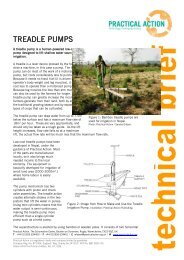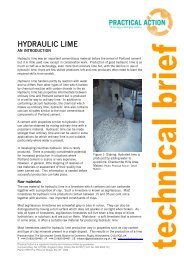Rainwater Harvesting
Rainwater harvesting - Worldwide Helpers
Rainwater harvesting - Worldwide Helpers
You also want an ePaper? Increase the reach of your titles
YUMPU automatically turns print PDFs into web optimized ePapers that Google loves.
<strong>Rainwater</strong> harvesting<br />
Practical Action<br />
of an integrated water supply system. It is a technology that is flexible and adaptable to a very<br />
wide variety of conditions. RWH is used in the richest and the poorest societies on our planet,<br />
and in the wettest and the driest regions of the world.<br />
Components of a domestic RWH system<br />
Domestic RWH systems (DRWH) vary in complexity. Some of the traditional Sri Lankan<br />
systems are no more than a pot situated under a piece of cloth or a plastic sheet tied to four<br />
poles. The cloth captures the water and diverts it through a hole in its centre into the pot. In<br />
contrast, some of the sophisticated systems manufactured in Germany incorporate clever<br />
computer management systems, submersible pumps, and links to grey water and domestic<br />
plumbing system mains. Somewhere between these two extremes, we find the typical DRWH<br />
system in use in developing countries. Such a system will usually comprise a collection<br />
surface (a clean roof or ground area), a storage tank, and guttering to transport the water from<br />
the roof to the storage tank. Other peripheral equipment is sometimes incorporated, for<br />
example: first-flush systems to divert the dirty water which contains roof debris after<br />
prolonged dry periods; filtration equipment and settling chambers to remove debris and<br />
contaminants before water enters the storage tank or cistern; handpumps for water extraction;<br />
water level indicators, etc.<br />
Typical domestic RWH systems<br />
A typical domestic RWH consists of a collection surface, gutters and a storage container. In<br />
addition, there are options for diverting first-flush water and filtration.<br />
Collection surfaces<br />
For domestic rainwater harvesting<br />
the most common surface for<br />
collection is the roof of the<br />
dwelling. Many other surfaces can<br />
be, and are, used: courtyards,<br />
threshing areas, paved walking<br />
areas, plastic sheeting, trees, etc.<br />
In some cases, as in Gibraltar, large<br />
rock surfaces are used to collect<br />
water which is then stored in large<br />
tanks at the base of the rock slopes.<br />
Figure 1: A typical corrugated iron sheet roof,<br />
showing guttering. Photo: Practical Action<br />
The style, construction and material<br />
of the roof affect its suitability as a<br />
collection surface for water. Typical<br />
materials for roofing include<br />
corrugated iron sheet (also known<br />
as tin roof), asbestos sheet; tiles (a wide variety is found), slate, and thatch (from a variety of<br />
organic materials). Most thatch are suitable for collection of rainwater, but only certain types<br />
of grasses e.g. coconut and anahaw palm (Gould and Nissen Peterson, 1999), thatched<br />
tightly, provide a surface adequate for high quality water collection. The rapid move towards<br />
the use of corrugated iron sheets in many developing countries favours the promotion of<br />
RWH.<br />
Guttering<br />
Guttering is used to transport rainwater from the roof to the storage vessel. Guttering comes<br />
in a wide variety of shapes and forms, ranging from the factory made PVC type to home-made<br />
guttering using bamboo or folded metal sheet (Figure 1). Guttering is usually fixed to the<br />
building just below the roof and catches the water as it falls from the roof.<br />
Some common types of guttering and fixings are shown in Figure 2:<br />
2





